Dry Needling CPT Codes: An Ultimate Guide
One of the trickiest physical therapy CPT codes that billers deal with is dry needling codes. Let’s take a look at the importance of CPT codes in general, what dry needling is, what the codes entail, and more!
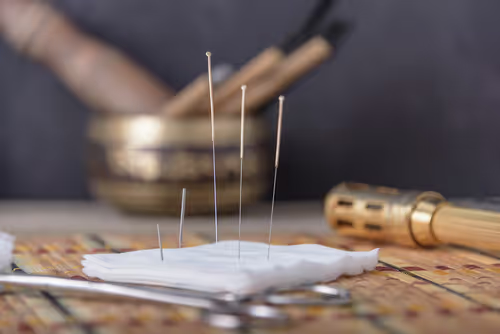
The US Bureau of Labor Statistics predicts a 15 percent growth in physical therapist employment opportunities from 2022 to 2032. This is a much faster growth projection than the average of most other occupations. The increasing demand for physical therapists comes from the need to replace workers exiting the practice combined with other factors including:
- Age-related physical therapy for baby boomers.
- Better quality of life for patients while reducing ER visits and readmission rates.
- Physical therapy in younger patients due to sports injuries.
The growth of this industry stretches beyond needing more physical therapists. In fact, the need for skilled medical billers and coders is also expected to rise. In order to stay in business, you need to be able to collect payments in a prompt and timely manner. So making sure your medical billing and coding team is on top of their game should be one of your practice’s top priorities.
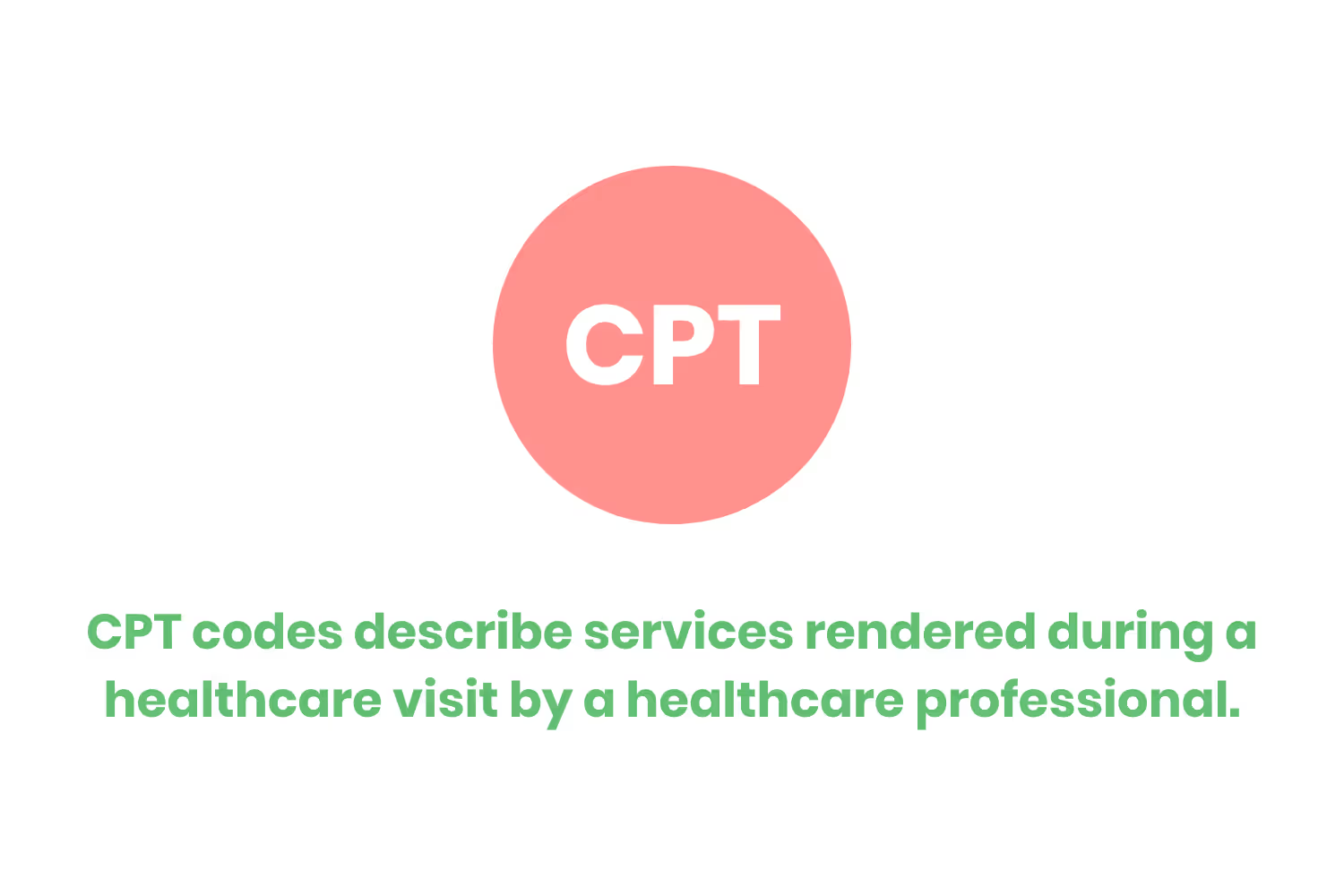
Current Procedural Terminology (CPT) codes are so important to understand when it comes to having a better-streamlined revenue cycle for your company. If you don’t know, CPT codes describe services rendered during a healthcare visit by a healthcare professional. These codes allow physicians to receive reimbursement for performed services from payers. Without proper billing and coding, physical therapists will lose out on revenue.
This doesn’t just apply to physical therapy practices either. A lack of accurate billing and coding processes in any healthcare field can negatively affect a company’s financial well-being. But we are here to talk about physical therapy medical billing specifically, so let’s get back to that.
One of the trickiest physical therapy CPT codes that billers deal with is dry needling codes. Let’s take a look at the importance of CPT codes in general, what dry needling is, what the codes entail, and more!
What is Dry Needling?
We already touched on CPT codes and why they are important, but there’s more to it than meets the eye. Especially when it comes to physical therapy and dry needling codes. These dry needling codes are a part of the Level I CPT codes. For Level I CPT codes, there are a few requirements and criteria that services or procedures must meet.
First, physicians or other qualified healthcare professionals across the United States must regularly perform the service/procedure. The service/procedure must also be consistent with current healthcare practices. Finally, there should be proof that this procedure or service meets clinical efficacy requirements. For your reference, these requirements are in the CPT code change application.

Since January 21, 2020, Medicare covers all types of acupuncture. This includes dry needling for chronic low back pain, so long as it is within specific guidelines in accordance with NCD 30.3.3. So what exactly is dry needling?
All this talk about dry needling, and while I’m sure you are wondering what it is, it’s kind of exactly what it sounds like. Trigger Point Dry Needling (TPDN) is a technique that specialists and physical therapists, use to treat pain and movement issues by inserting thin needles through a patient’s skin to treat myofascial trigger points. Trigger points are tender portions of a muscle that are highly sensitive to touch.
Inserting these needles helps to alleviate the pain in that trigger point area, without containing medication. Thus, professionals refer to it as “dry” needling. Dry needling is helpful for decreasing tightness and increasing blood flow in the body and can treat a myriad of conditions. Some conditions include the following:
- Tendonitis and migraines.
- Spinal issues and whiplash.
- Carpal tunnel syndrome.
- Joint issues and disk issues.
Common Dry Needling CPT Codes
The complications associated with this CPT category don't have to do with the amount of codes you need to learn… unlike other CPT categories, which can have hundreds of codes. The Centers for Medicare & Medicaid Services (CMS) approved only 2 CPT codes for dry needling: 20560 & 20561. So thankfully, these are easy to remember.
CPT code 20560 covers needle insertion without injection in 1 or 2 muscles. Whereas CPT code 20561 also covers needle insertion without injection but focuses on 3 or more muscles. The complication and confusion come from what services these codes will cover and what they won’t.
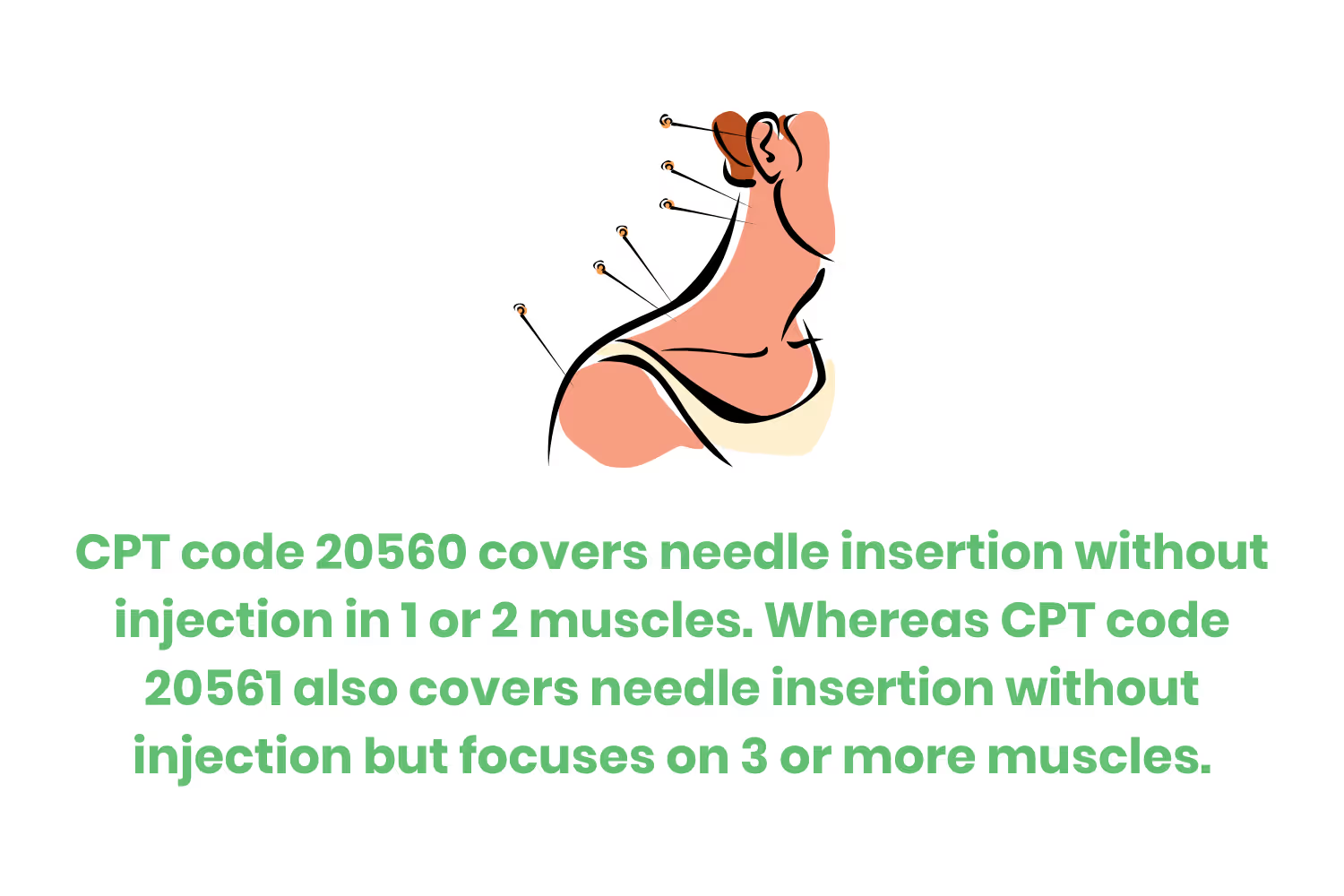
These CPT codes only cover chronic lower back pain (cLBP), as I mentioned earlier in this blog. But what are the requirements for this diagnosis? They include:
- Pain/issues that last 12 weeks or longer.
- Nonspecific. This means that there is no identifiable systemic cause for the pain/issues. Systemic causes might include metastatic, inflammatory, infectious, etc disease.
- Issues/pain not associated with surgery.
- Issues/pain not associated with pregnancy.
Medicare covers up to 12 visits in 90 days. They also may cover another 8 sessions after the initial 12 if the patient sees improvement. Professionals may not administer more than 20 acupuncture treatments annually, and if there is no improvement it is possible for Medicare to terminate the treatment. As for all other conditions, dry needling is not covered.
Dry Needling CPT Code Tips
When coding for dry needling, there are a few helpful tips you should consider. For one thing, you should not include dry needling when you use manual therapy codes. CPT code 97140 is an example of a manual therapy code, and this also goes for neuromuscular re-education codes. Neuromuscular re-education falls under CPT code 97112, for your reference.
Note that dry needle codes are not meant to bundle with another defined service, which falls under an activity known as “treatment bundling”. Treatment bundling is actually a form of billing fraud, so always make sure to double-check your billing practices for this mistake.
However, manual therapy is usually part of a complete treatment plan that addresses issues with soft tissue and myofascial pain. So including this soft tissue assessment and patient management time as your manual therapy minutes while providing dry needling is acceptable.
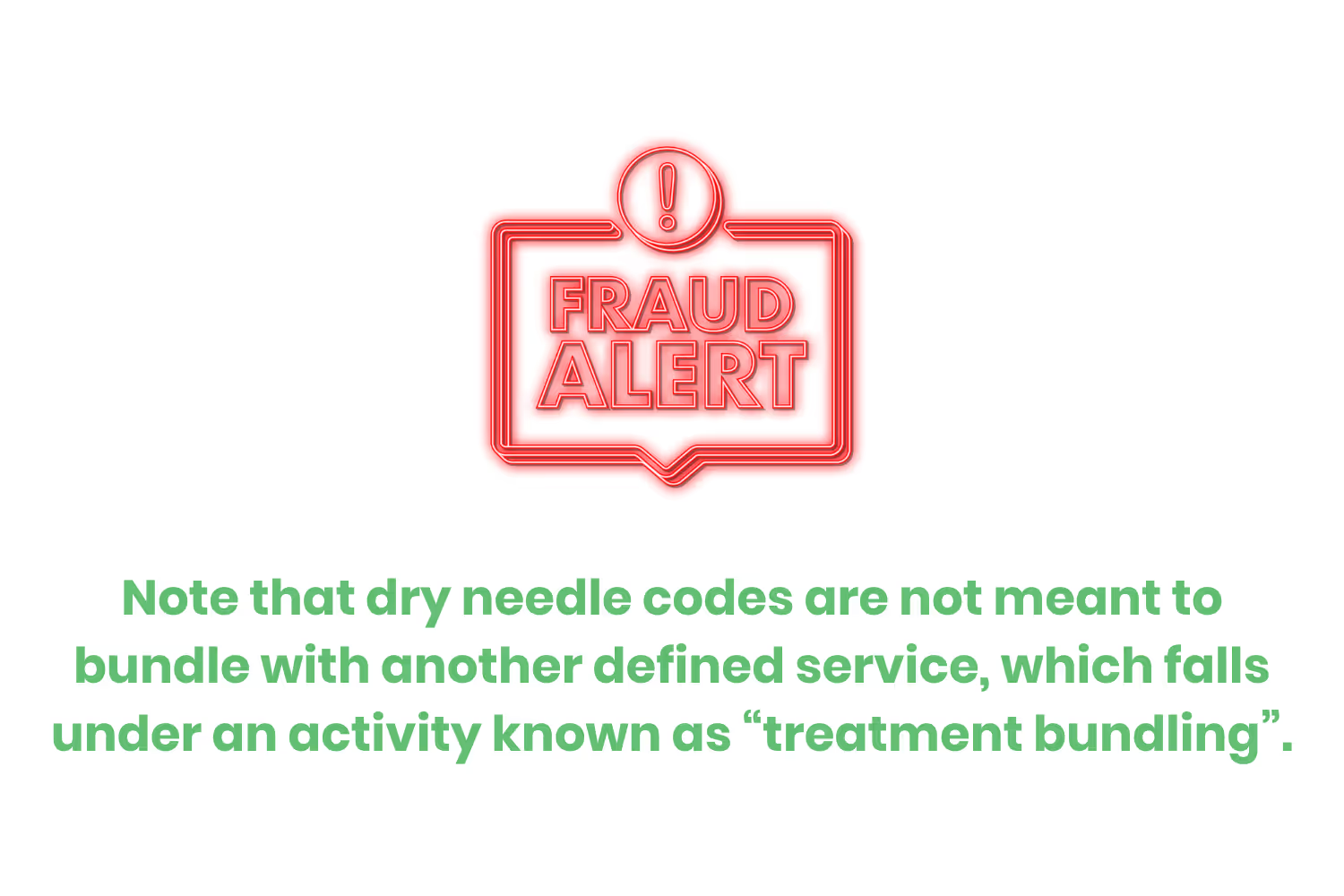
Another tip comes from knowing the difference between the coding practices for acupuncture and TPDN. Both of these techniques use dry needles. But while a provider can perform TPDN with acupuncture needles, they cannot perform acupuncture using TPDN codes. This may be confusing to some, as trigger points and acupuncture points often coincide in location on the body. Just remember that codes 20560 and 20561 are for TPDN use only.
Acupuncture is also separately licensed from physical therapy and occupational therapy practices in most states. You should not bill acupuncture as TPDN even with a license to perform acupuncture. Note that if your dry needling course involves training about needling acupuncture points, be aware. You should always keep these similarities between the services in mind while performing and documenting these techniques.
Non-Covered TPDN
When TPDN services are not covered you are likely to deal with either one of these two terms: a “non-covered” service or a “not medically necessary service”. A non-covered service is simply not paid because that service does not fall under a patient’s plan. While a “not medically necessary service” is a service provided which is not recognized, is not effective, or is experimental with unproven effectiveness.
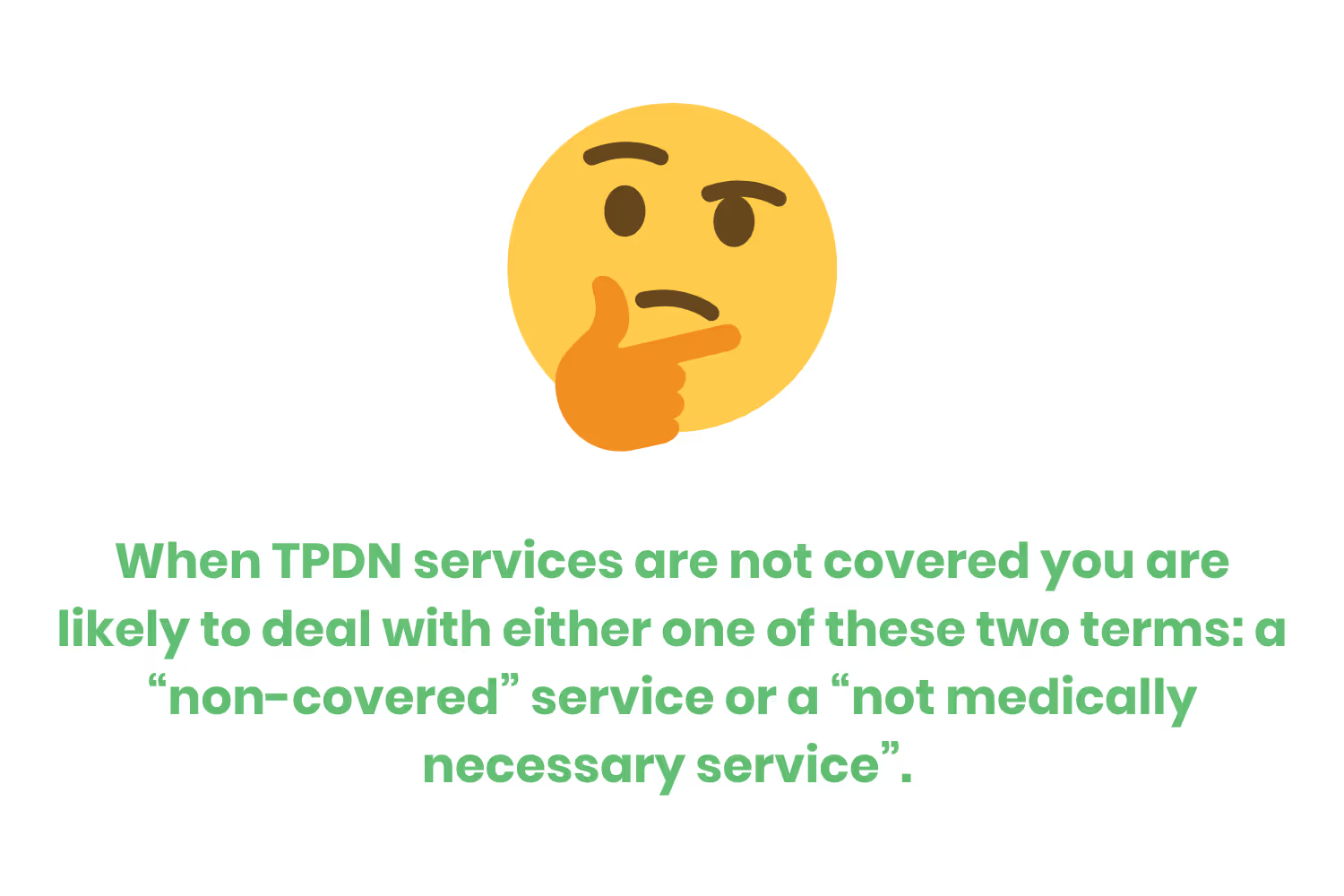
It is important to note that the explanation of benefits (EOB) or electronic remittance advice (ERA) will not place responsibility for a “not medically necessary service” on the patient. So if you see TPDN falls under this category, do not provide it to your patients. If you aren’t sure if your payer pays for TPDN services, check their outpatient rehabilitation services policy. You can also look at their trigger point injection policy, as well.
Conclusion
There's a huge, upcoming demand for physical therapists. This also means that there's an equal demand for experienced medical billers.
As the population continues to age a few things happen. First, lifestyles become more active. Second, industry technology/techniques continue to advance. Both of those factors explain the rising need for physical therapy services.
Understanding the correct CPT codes to use for these physical therapy services is pinnacle. Especially those related to dry needling. Making sure to incorporate the correct codes in your medical billing practice is a crucial part of financial viability. Staying informed and being able to adapt to industry changes keeps your practice ahead of the curve.
Emphasize your product's unique features or benefits to differentiate it from competitors
In nec dictum adipiscing pharetra enim etiam scelerisque dolor purus ipsum egestas cursus vulputate arcu egestas ut eu sed mollis consectetur mattis pharetra curabitur et maecenas in mattis fames consectetur ipsum quis risus mauris aliquam ornare nisl purus at ipsum nulla accumsan consectetur vestibulum suspendisse aliquam condimentum scelerisque lacinia pellentesque vestibulum condimentum turpis ligula pharetra dictum sapien facilisis sapien at sagittis et cursus congue.
- Pharetra curabitur et maecenas in mattis fames consectetur ipsum quis risus.
- Justo urna nisi auctor consequat consectetur dolor lectus blandit.
- Eget egestas volutpat lacinia vestibulum vitae mattis hendrerit.
- Ornare elit odio tellus orci bibendum dictum id sem congue enim amet diam.
Incorporate statistics or specific numbers to highlight the effectiveness or popularity of your offering
Convallis pellentesque ullamcorper sapien sed tristique fermentum proin amet quam tincidunt feugiat vitae neque quisque odio ut pellentesque ac mauris eget lectus. Pretium arcu turpis lacus sapien sit at eu sapien duis magna nunc nibh nam non ut nibh ultrices ultrices elementum egestas enim nisl sed cursus pellentesque sit dignissim enim euismod sit et convallis sed pelis viverra quam at nisl sit pharetra enim nisl nec vestibulum posuere in volutpat sed blandit neque risus.

Use time-sensitive language to encourage immediate action, such as "Limited Time Offer
Feugiat vitae neque quisque odio ut pellentesque ac mauris eget lectus. Pretium arcu turpis lacus sapien sit at eu sapien duis magna nunc nibh nam non ut nibh ultrices ultrices elementum egestas enim nisl sed cursus pellentesque sit dignissim enim euismod sit et convallis sed pelis viverra quam at nisl sit pharetra enim nisl nec vestibulum posuere in volutpat sed blandit neque risus.
- Pharetra curabitur et maecenas in mattis fames consectetur ipsum quis risus.
- Justo urna nisi auctor consequat consectetur dolor lectus blandit.
- Eget egestas volutpat lacinia vestibulum vitae mattis hendrerit.
- Ornare elit odio tellus orci bibendum dictum id sem congue enim amet diam.
Address customer pain points directly by showing how your product solves their problems
Feugiat vitae neque quisque odio ut pellentesque ac mauris eget lectus. Pretium arcu turpis lacus sapien sit at eu sapien duis magna nunc nibh nam non ut nibh ultrices ultrices elementum egestas enim nisl sed cursus pellentesque sit dignissim enim euismod sit et convallis sed pelis viverra quam at nisl sit pharetra enim nisl nec vestibulum posuere in volutpat sed blandit neque risus.
Vel etiam vel amet aenean eget in habitasse nunc duis tellus sem turpis risus aliquam ac volutpat tellus eu faucibus ullamcorper.
Tailor titles to your ideal customer segment using phrases like "Designed for Busy Professionals
Sed pretium id nibh id sit felis vitae volutpat volutpat adipiscing at sodales neque lectus mi phasellus commodo at elit suspendisse ornare faucibus lectus purus viverra in nec aliquet commodo et sed sed nisi tempor mi pellentesque arcu viverra pretium duis enim vulputate dignissim etiam ultrices vitae neque urna proin nibh diam turpis augue lacus.




